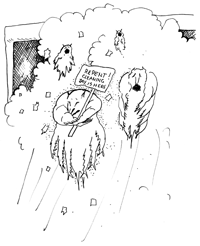STRANGE BUT TRUE- Mitey crowded: What happens inside your vacuum

DRAWING BY DEBORAH DERR McCLINTOCK
Q. Buried deep in your living room carpet, hidden amid the thick fibers like clans of forest tribesmen, are legions of dust mites, too small to be seen with the naked eye. What day of the week is most eventful for them? –T. Platts-Mills
A. Vacuuming day. Suddenly comes a big wind, sweeping them upward, the dead and living alike, says David Bodanis in The Secret House. First to go are the babies, holding on eight-leggedly for all they're worth. Then the adults follow. "It sounds horrendous, but we're not mites."
Most of the upswept population land safely in the piles of cushioning dust inside the cleaner's bag. "Nor is this just ordinary sneeze-producing and forget-about-it dust. Sucked up in the house, this dust has a terrific number of human skin flakes in it, and skin flakes are the favorite food of these mites. They have landed in dust mite heaven."
Feeding most of the time and copulating the rest, whole generations come of age inside the bag, with a few days enough to bring a juvenile to puberty. The next great event is the emptying of the bag, when a goodly number escape back into the house, many landing on the new alien terrain of the kitchen floor while others ride air currents for an hour or more back to their original homeland, the living room carpet, thus closing the loop on a mite of history.
Q. Beyond the safe cocoon of Earth, how hostile an environment for humans is "outer space"? –R. Asimov
A. Dark and fierce– the most unforgiving Himalayan peaks are nursery-school friendly by comparison, says Bob Berman in Cosmic Adventure. Invisible apple seed-sized meteorites streak through the void at speeds 20 times faster than bullets, able to puncture a space suit like a knife and pass through a body as through a cloud of fog.
The sun's searing ultraviolet rays would burn exposed skin within seconds, cook it to carbon in three minutes. The sunward side of an unprotected body would heat like a microwave to 250 degrees F while the shady side rapidly froze to minus 240, "cracking" the skin into solid ice.
Take a space entourage near Jupiter, and the cyclotron-level radiation would sterilize all living tissue. Near a star, bodies would immediately blister, char and then vaporize. Near a white dwarf or neutron star, "tidal effects would rip one's skeleton to pieces."
But most of space is simply dark and cold, where a person, of mostly water, would turn into a block of ice that, if struck by drifting debris, would "shatter into pieces, perhaps dividing itself along internal 'fault structures' defined by organs and tissues."
Q. If angels really existed and could fly, from a structural standpoint what would they have to look like? –L.U. Cifer
A. Assuming angels weighed like a person and their muscles generated power pound for pound like those of an eagle or pigeon, they would need a chest four feet thick to house muscles big enough for flight, while to economize on weight, their legs would have to be reduced to mere stilts, says biologist J.B.S. Haldane in On Being the Right Size.
Aerodynamically, an angel twice the height of an eagle would need to fly 50 percent faster than the eagle to stay aloft. Actually, large birds remain airborne more by soaring, balanced on a rising column of air, than by wing- flapping. And even soaring only works up to a point. "Were this not the case eagles might be as large as tigers and as formidable to humans as hostile airplanes," sats Haldane.
Q. Classic numbers noodler directs you to write down any multi-digit number without repeat digits, e.g., 8491 but not 8498, then rearrange the digits anywhichway (e.g., 1498), then subtract the smaller number from the larger (8491 - 1498 = 6993). Now add up the digits in your answer (6 + 9 + 9 + 3 = 27). If this yields a multi-digit number, tally the digits again (2 + 7 = 9). What number did you end up with? See the trick here? –R. Descartes
A. Whatever your original number, your answer will always be 9, once you arrive at a single digit, says California State Polytechnic University mathematician Laurie Riggs. "Amazing!"
~
Send strange questions to brothers Bill and Rich at [email protected].
#